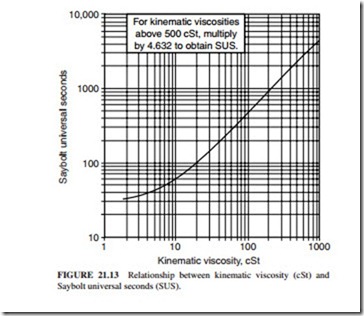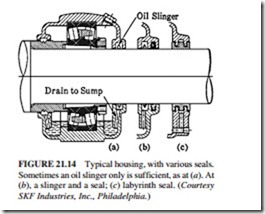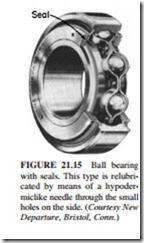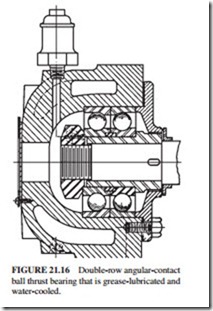LUBRICATION
The Viscosity of Lubricants
The viscosity is defined as the resistance of a liquid to flow or deformation. In general, the slower a fluid flow under a given pressure drop, the higher its viscosity. The ability of a lubricant to maintain an oil film (which reduces friction and wear) between the working parts of machines is determined by viscosity.
Figure 21.12 illustrates two parallel plates separated by a film of oil. The top plate is moving; the bottom plate is stationary. A force is applied to the top plate to keep it moving at a steady speed.
Water and most industrial oils follow this equation (newtonian fluids). The shear stress increases in direct proportion to the shear rate. The viscosity is independent of the shear stress or shear rate at which it is measured.
Nonnewtonian fluids exhibit a nonlinear relationship between the shear stress and the shear rate. Greases and oils below their solidification temperature are nonnewtonian lubricants.
The equation of viscosity can be rearranged to show that the force is proportional to the viscosity and the speed is inversely proportional to the viscosity.
Viscosity Units. The physical quantity in the equation above is the dynamic viscosity (also called absolute viscosity). However, the kinematic viscosity is traditionally used when referring to lubricants. The two measures of viscosity are related by density, as shown:
Dynamic viscosity kinematic viscosity X density
The friction in bearings or pressure loss in horizontal pipe flow is not affected by the density. Therefore, the dynamic viscosity is the controlling measure.
However, density has a significant effect on gravitational flow, such as flow from a reservoir through a hose. The driving force is proportional to the density in this situation, and the kinematic viscosity is the controlling measure.
The lubrication industry has traditionally used the kinematic viscosity. This viscosity is obtained by measuring the flow rate from a reservoir through a small capillary. The unit of kinematic viscosity in the International System (SI) is millimeters per second (mm/s). However, the lubrication industry has traditionally used the term centistokes (1 cSt 1 mm/s).
The unit of dynamic viscosity in SI is the pascal-second (Pa·s). However, the lubrication industry has traditionally used the term centipoises (1 cP 1 mPa·s). This equation is used to convert from kinematic viscosity to dynamic viscosity:
A reference point for viscosity is water at room temperature which has a viscosity of 1 cSt approximately. The viscosity of a typical engine oil at 280°F is 5 to 6 cSt. The viscos- ity of the same oil at -25°C is between 3000 and 3500 cP (temperature has a significant effect on viscosity).
Significance of Viscosity. Viscosity is the most important property of lubricating oils. In bearings, oil prevents wear between mating surfaces by keeping them separated, minimizes friction between rubbing surfaces, and removes heat generated by surface contact. Viscosity is important in all these functions.
The role of viscosity is illustrated in plain journal bearings. When the viscosity is high, the bearing load is completely separated by the oil film. The journal does not contact the bear- ing, and the friction is low. When the viscosity is low, the metal-to-metal contact and the friction are high. In this case, the oil viscosity has a minor effect. The antiwear properties of the oil play a major role. The antiwear properties of the oil play a minor role when the viscosity is high enough to support the bearing load completely.
The friction between the moving parts is reduced by lubricants even if the oil film does not carry the load. The effect of the lubricant viscosity is to “cushion” the asperity-to-asperity (microscopic hills) contact between moving surfaces to reduce the local stresses. The contact between the parts in roller bearings and gear teeth is along a line (one gear tooth against another). A very thin film is trapped between the surfaces due to the high contact pressure. The pressure in these contact zones increases to several hundred thousand pounds per square inch, which results in significant increase in viscosity.
The viscosity of the oil becomes high enough to keep the moving surfaces separated. This mechanism of lubrication is called elastohydraulic lubrication. The oil viscosity at these high pressures has a major role in determining the film thickness in such contacts.
The oil viscosity should be carefully selected to ensure proper lubrication. If the vis- cosity is low, high wear rates and frequent failures will result. If the viscosity is too high for the application, a significant amount of heat would be generated. This may lead to failures due to high temperature. Most manufacturers specify the viscosity required for their machines.
Flow-Through Pipes. In laminar flows through pipes, viscosity plays an important role. In this case, the pressure loss is proportional to the fluid viscosity. The flow rate is inversely proportional to the viscosity. When the flow through pipes becomes turbulent, the fluid friction increases by a factor of 6. The viscosity has a minor effect on pressure loss while the pipe roughness has a major effect.
Variation of Viscosity with Temperature and Pressure
Temperature Effect. The viscosity of all fluids is inversely proportional to temperature. The oil viscosity is reported at two standard temperatures, 40 and 100°C. MacCoull’s equation describes the variation of viscosity with the temperature of simple lubricants:
Note: MacCoull’s equation is not accurate if the oil has additives or if the viscosity is lower than 1 cSt.
Viscosity Index. The viscosity index (VI) characterizes the change of viscosity with tem- perature. A high VI indicates a small change in viscosity with temperature. A low VI indi- cates a large change.
Effects of Pressure on Viscosity. The viscosity of all fluids increases with pressure.
Nonnewtonian Fluids
In newtonian fluids, the shear stress (force/area) is proportional to the applied shear rate (speed/thickness of oil film). Thus, the viscosity, which is the ratio of these properties, is constant.
Nonnewtonian fluids exhibit a nonlinear relationship between the shear stress and the shear rate. The viscosity of some nonnewtonian fluids changes with time after a flow starts. Nonnewtonian fluids are characterized by a graph of shear stress versus shear rate. The three classes of nonnewtonian fluids in the lubrication industry are greases, VI improved oils, and oils at low temperature (near the pour points).
Greases. The viscosity of greases is time-dependent. The viscosity is relatively high when the flow starts. Then it decreases as the flow progresses. The yield stress of a grease is the minimum stress required to cause a flow.
VI Improved Oils
VI improvers are often included in oils to expand the useful range of operating temperature to permit low viscosities for low-temperature start-up, while still providing adequate viscosities at operating temperatures.
Organic polymers are the active ingredients in VI improvers. They are extremely large molecules containing many thousands of carbon atoms. The concentration of polymer in VI improved oils is about 1 percent. However, this is sufficient to cause major effects on viscosity.
The viscosity of VI improved oil at 210 and 0°F is about 1.8 and 1.2 times the viscosity of the base oil, respectively. The viscosity of polymer-thickened oils (VI improved oils) decreases while the oil is in service. This loss is called the permanent viscosity loss (PVL). The shear stability is the resistance of the oil to this loss. In engine service, the oil viscosity decreases 7 to 14 percent of its 100°C kinematic viscosity after 500 to 1500 mi of service.
Oils at Low Temperatures
The viscosity of the oil increases rapidly as the temperature decreases. If the lubricant is used below its pour point, the machinery may experience severe problems. The working parts of the machinery may be covered fast enough by oil. This leads to high wear and could result in total failure.
The pour point is usually lowered by adding certain additives called pour point depressants.
Variation of Lubricant Viscosity with Use
Oxidation Reactions. The viscosity of the oil increases when it is placed in service. This phenomenon is significant when the oil is subjected to excessive heat. Some of the oil mol-
ecules react with oxygen to form oxygenated molecules. This increases the oil viscosity and darkens its color. In service, heat can result in a serious problem. Some lubricants contain antioxidant additives to control oxidative thickening.
Physical Reactions. The mineral oil is composed of a broad range of molecular types and sizes. The lower-viscosity molecules tend to evaporate in a hot environment while the heavier, higher-viscosity molecules remain. This results in an overall increase in viscosity.
Housing and Lubrication
Cleanliness has a major effect on the life of a rolling bearing. For this reason, these bear- ings must be protected from airborne particles and expected sources of dirt. Figure 21.14 illustrates typical bearing housing with various seals.
Interference fits for the rings must be tight to prevent relative motion. The bearings are usually mounted against a shoulder which makes it possible to move them off without transmitting the force through the rolling elements.
Grease is usually used at low and medium speeds because it provides a better seal against dirt. It is suitable for temper- atures from -70 to 210°F. It is preferable not to pack tightly the bearing and the housing with grease. Two-thirds full is usually enough.
Oil is used at higher speeds. The oil level should be kept below the center of the lowest rolling element, as shown in Fig. 21.14. Otherwise, excessive churning of the oil at high speed will cause overheating.
For a particular method of lubrication, the coefficient of friction is almost constant. Hence, the temperature rise under constant load is almost proportional to the speed.
Some bearings are cooled by circulating and cooling the oil due to excessive generation of heat.
Some prelubricated bearings having integral seals to run for the life of the bearing (or machine) without any required maintenance. Figure 21.15 illustrates a typical ball bearing with seals. The seals are usually found on one or both sides.
Sealed prelubricated bearings require attention if they are not operated for a long time. The shaft should be rotated occasionally (once every 3 months) to move the lubricant and maintain a film coating of the balls.
The self-aligning ball bearings have been operated satisfactorily at high speeds. They also have a long life and very minimal thrust capacity.
The self-aligning spherical roller bearings are used for larger shafts and for applications having a considerable thrust component.
The single-row deep-groove ball bearing is used most commonly on centrifugal pumps having a relatively small diameter. It is capable of handling radial as well as axial loads. This type of bearing sometimes has seals to exclude dirt and retain lubricant.
The angular-contact bearing is good for heavy thrust loads. The single-row type is good for thrust in one direction only (commonly used on vertical pumps). The double-row type is capable of handling thrust in both directions (Fig. 21.16).
Lubrication of Antifriction Bearings. In general, the choice of lubricant is dictated by the application and the cost. For example, water is the preferred lubricant for vertical wet-pit condenser circulating pumps (Fig. 21.17). If oil or grease were used and the lubricant leaked, the condenser operation might be seriously affected because the lubricant will coat the tubes.
Most ball bearings used for centrifugal pumps are grease-lubricated bearings.
Figure 21.17 illustrates the seals required within the housing of some bearings to prevent the lubricant from escaping.
The proper grease circulation within the bearing and the housing is prevented if the bearing is overfilled with grease. Only one-third of the void spaces in the housing should be filled. Any additional amount of grease will cause the bearing to overheat, and the grease will flow out of the seal to relieve the pressure. If the grease cannot escape through the seal or through the relief cock, the bearing will fail early.
The oil is supplied to the bearing from the bearing housing reservoir by oil rings, as shown in Fig. 21.18. A constant-level oiler is used sometimes, as shown in Fig. 21.19.
It is advantageous to have the capability to interchange the lubricant. Some pump lines are built with bearing housing that is capable of using oil or grease lubrication with minimal modifications (Fig. 21.20).





